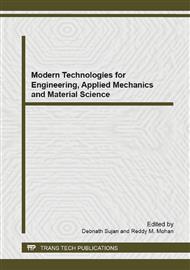[1]
K. Kabiri, H. Omidian, M.J. Zohuriaan-Mehr and S. Doroudiani, Superabsorbent Hydrogel Composites and Nanocomposites: A Review, Pol. Comp. (2011).
DOI: 10.1002/pc.21046
Google Scholar
[2]
R. Liang, H. Yuan, G. Xi and Q. Zhou, Synthesis of wheat straw-g-poly(acrylic acid) superabsorbent composites and release of urea from it, Carb. Pol. (2009) 1-7.
DOI: 10.1016/j.carbpol.2008.12.018
Google Scholar
[3]
L. Xie, M. Liu, B. Ni, X. Zhang and Y. Wang, Slow-release nitrogen and boron fertilizer from a functional superabsorbent formulation based on wheat straw and attapulgite, Chem. Eng. J. 167 (2011) 342–348.
DOI: 10.1016/j.cej.2010.12.082
Google Scholar
[4]
H.X. Sheng, L.Z. Wen, H.P. Zhao, D.J. Xian, G.R. Shan, L.H. Bo and G.Z. Chao, Characteristics and performance of novel water absorbent slow release nitrogen fertilizers, Agri. Sci. in China. 6 (2007) 338-346.
Google Scholar
[5]
N.E. Rabat, S. Hashim and R.A. Majid, Effect of oil palm empty fruit bunch-grafted-poly(acrylic acid-co-acrylamide) hydrogel preparations on plant growth performance, Adv. Mat. Eng. and Tech. II. 236 (2014) 594-595.
DOI: 10.4028/www.scientific.net/kem.594-595.236
Google Scholar
[6]
J. Zhang and A. Wang, Study on superabsorbent composites. IX: synthesis, characterization and swelling behaviors of polyacrylamide/clay composites based on various clays, React. & Func. Pol. 67 (2007) 737–745.
DOI: 10.1016/j.reactfunctpolym.2007.05.001
Google Scholar
[7]
M. Teodorescu, A. Lungu, P.O. Stanescu and C. Neamt, Preparation and properties of novel slow-release NPK agrochemical formulations based on poly(acrylic acid) hydrogels and liquid fertilizers, Ind. & Eng. Chem. Res. 48 (2009) 6527–6534.
DOI: 10.1021/ie900254b
Google Scholar
[8]
K. Kabiri, H. Omidian, S.A. Hashemi and M.J. Zohuriaan-Mehr, Synthesis of fast-swelling superabsorbent hydrogels: effect of crosslinker type and concentration on porosity and absorption rate, Euro. Pol. J. 29 (2003) 1341–1348.
DOI: 10.1016/s0014-3057(02)00391-9
Google Scholar
[9]
N. Bicak, B.F. Senkal and M. Gazi, Hydrogels prepared by crosslinking copolymerization of N-allyl maleamic acid with acrylamide and acrylic acid, Des. Mono. and Pol. 7 (2004) 261–267.
DOI: 10.1163/156855504774076271
Google Scholar


